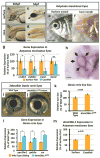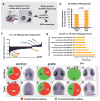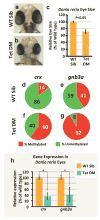An epigenetic mechanism for cavefish eye degeneration
- PMID: 29807993
- PMCID: PMC6023768
- DOI: 10.1038/s41559-018-0569-4
An epigenetic mechanism for cavefish eye degeneration
Abstract
Coding and non-coding mutations in DNA contribute significantly to phenotypic variability during evolution. However, less is known about the role of epigenetics in this process. Although previous studies have identified eye development genes associated with the loss-of-eyes phenotype in the Pachón blind cave morph of the Mexican tetra Astyanax mexicanus, no inactivating mutations have been found in any of these genes. Here, we show that excess DNA methylation-based epigenetic silencing promotes eye degeneration in blind cave A. mexicanus. By performing parallel analyses in A. mexicanus cave and surface morphs, and in the zebrafish Danio rerio, we have discovered that DNA methylation mediates eye-specific gene repression and globally regulates early eye development. The most significantly hypermethylated and downregulated genes in the cave morph are also linked to human eye disorders, suggesting that the function of these genes is conserved across vertebrates. Our results show that changes in DNA methylation-based gene repression can serve as an important molecular mechanism generating phenotypic diversity during development and evolution.
Conflict of interest statement
The authors declare no competing financial interests.
Figures




Comment in
-
All eyes on rapid adaptive evolution.Nat Rev Genet. 2018 Aug;19(8):472. doi: 10.1038/s41576-018-0027-9. Nat Rev Genet. 2018. PMID: 29907763 No abstract available.
References
Publication types
MeSH terms
Grants and funding
LinkOut - more resources
Full Text Sources
Other Literature Sources
Molecular Biology Databases

